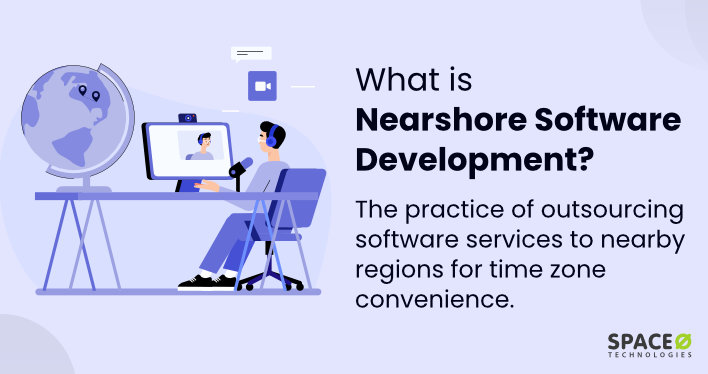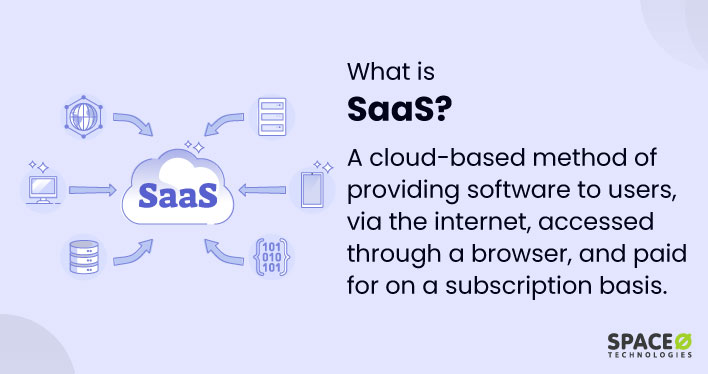Table of Contents
What is Nearshore Software Development?
Nearshore software development is the practice of outsourcing software projects to companies situated in nearby countries and within the same time zone. Geographic proximity, cultural affinity, and synchronized office hours make this approach an excellent option for businesses looking for successful teamwork and interaction from an outsourcing software development company.
When compared to other methods of software development outsourcing, such as offshore (hiring from afar) or onshore (hiring inside the same country), nearshore is often a superior alternative. It is generally less expensive than onshore but still provides better connectivity than offshore. This makes nearshore outsourcing a popular choice for many businesses.
A Detailed Comparison of Nearshore vs. Offshore vs. Onshore
Here is a table that contains a detailed comparison of nearshore, offshore and onshore.
| Aspects | Nearshore Software Development | Offshore Software Development | Onshore Software Development |
|---|---|---|---|
| Geographical Proximity | Close to the client’s country. | Typically in a different continent. | Within the same country. |
| Time Zone Alignment | Similar or overlapping time zones. | Significant time zone differences. | Same time zone. |
| Cost Efficiency | More cost-effective than onshore, higher than offshore. | Most cost-effective due to lower labor costs. | Most expensive due to higher local labor costs. |
| Communication | Easier due to similar time zones and cultural familiarity. | Challenging due to time differences and language barriers. | Very efficient with minimal barriers. |
| Quality of Talent | High quality, good balance of cost and skill. | Varies, some regions are known for high-quality talent. | Typically high, with a wide range of skilled professionals. |
| Risk Management | Lower risk due to closer oversight. | Higher risk due to distance and communication barriers. | Lowest risk, with high control and quick response capabilities. |
Now, you know the exact differences between all of these development models. So, now let’s discuss the advantages of nearshore software development.
7 Advantages of Nearshore Software Development
Here are the advantages associated with nearshore software development.
Streamlines Communication with Time Zone Alignment
Nearshore development facilitates smoother communication due to fewer time zone differences and often shared languages. This leads to more effective collaboration, quicker problem resolution, and a better understanding of software development project requirements.
Boosts Teamwork through Cultural Similarities
The cultural alignment with the nearshore software development team often translates into a more harmonious working relationship. Shared cultural values and business practices reduce misunderstandings and streamline project workflows, enhancing overall productivity.
Maximizes Cost Efficiency with Balanced Quality
Nearshore software development strikes a balance between quality and cost. It offers a cost-saving advantage over onshore development while maintaining higher quality standards and better oversight compared to offshore options.
Facilitates In-person Meetings with Geographical Proximity
Geographical proximity in nearshore outsourcing development simplifies travel for face-to-face meetings. This closeness is invaluable for complex projects, allowing for more direct engagement and stronger team relationships.
Enhances Productivity with Synchronized Working Hours
Operating in similar time zones enables real-time collaboration and immediate feedback, crucial for agile and iterative development processes. This alignment ensures that your team including developers, designers and project managers can work synchronously, enhancing efficiency and reducing delays.
Leverages High-quality Talent for Superior Outcomes
Nearshore regions are known for their skilled talent pools, providing access to high-quality software development professionals. This access ensures that software development projects are handled by competent teams, leading to innovative solutions and high-quality outcomes.
Minimizes Legal Risks with Aligned Compliance Standards
Proximity and similar legal frameworks with nearshore development reduce risks related to legal compliance, data security, and project management. This similarity facilitates a smoother process in handling legal and regulatory compliance, ensuring project stability and security.
5 Disadvantages and Solutions of Nearshore Software Development
Here are the disadvantages and their solutions for nearshore software development.
Higher Costs Compared to Offshore
Nearshore software development, while cost-effective compared to onshore options, often involves higher expenses than offshore outsourcing. This is due to the closer geographical proximity and generally higher wage standards in nearshore regions. For businesses operating on tight budgets, this cost difference can be a significant consideration, especially when large-scale development is involved.
An Effective Solution to This Challenge is to Blend Teams
To manage costs effectively, businesses can adopt a hybrid approach by combining nearshore teams for critical and complex tasks with offshore teams for routine development work, balancing quality and affordability.
Limited Scalability in Some Regions
In certain nearshore regions, the availability of specialized or high-volume technical talent can be limited. This scarcity can pose challenges for businesses looking to rapidly scale their development efforts or requiring niche expertise. Such constraints can hinder the pace of development and innovation.
An Effective Solution to This Challenge is to Diversify Locations
Expanding the nearshore strategy to include multiple regions can help overcome these limitations. By tapping into diverse talent pools across different nearshore areas, companies can ensure scalability and access to a wide range of skills.
Potential Language Barriers
Despite geographical and cultural proximity, language barriers can still exist in nearshore software development. These barriers can lead to miscommunications, misunderstandings, and a potential mismatch in project expectations, affecting the overall workflow and output quality.
An Effective Solution to This Challenge is Language Training
Implementing language training programs for both nearshore and onshore teams, along with utilizing effective communication tools, can bridge language gaps, ensuring clear and efficient project communication.
Minor Time Zone Differences
While nearshore development significantly reduces the challenges of time zone differences compared to offshore development, even minor discrepancies can impact the synchronization of development teams. This can affect real-time collaboration, especially in agile development environments where quick turnarounds are crucial.
An Effective Solution to This Challenge is Flexible Work Hours
Establishing flexible work schedules with overlapping hours ensures that teams have sufficient time for real-time collaboration and communication, maintaining the momentum of agile development processes.
Over Reliance on Proximity
Companies may become overly reliant on the geographical closeness offered by nearshore development, potentially underestimating the importance of robust remote working capabilities. This overreliance can lead to challenges in situations where physical proximity is not feasible, such as during unexpected events or travel restrictions.
An Effective Solution to This Challenge is to Strengthen Remote Infrastructure
Investing in and strengthening remote working technologies and practices ensures that teams remain productive and collaborative, regardless of physical distances or unforeseen circumstances.
Let’s discuss the steps involved in choosing the best nearshore development company.
How to Choose the Best Nearshore Software Development Company
Here are the 6 easy steps for choosing the best nearshore development outsourcing provider.
Define Your Project Scope and Technical Needs
- Outline specific project deliverables, technology stack requirements, and software development methodologies preferred (e.g., Agile, Scrum).
- Identify key roles and expertise needed, such as full-stack developers, UI/UX designers, or QA specialists.
Conduct Thorough Market Research
- Research nearshore software outsourcing companies in regions like Latin America, Eastern Europe, and North Africa, which are known for their software development capabilities.
- Review their portfolios for experience in technologies like JavaScript frameworks, cloud computing, AI, or mobile app development.
Assess Technical and Industry Expertise
- Evaluate their proficiency in programming languages and development tools relevant to your software development project (e.g., React, Node.js, Docker).
- Look for a nearshore software outsourcing provider who has experience in your specific industry sector, such as fintech, healthcare, or e-commerce.
Evaluate Communication Skills and Cultural Compatibility
- Assess language skills, particularly in English or your native language, for seamless communication.
- Consider cultural compatibility in terms of work ethics, business hours, and project management styles.
Analyze Cost Efficiency and Value Addition
- Compare their pricing models (e.g., fixed price, time and materials) and overall cost-effectiveness.
- Evaluate their value proposition in terms of innovation, scalability solutions, and speed of delivery.
Verify Client Feedback and Performance History
- Request client references to discuss their collaboration experience, project management, and delivery timelines.
- Check online platforms like Clutch or GoodFirms for reviews and ratings on their nearshore software development services.
Finally, nearshore software development stands out as a feasible and effective approach for businesses wishing to outsource their software projects. It efficiently bridges the cost-quality divide, providing a medium ground that meets a range of company demands.
As the field of software development continues to develop, nearshore solutions are proving to be an essential resource for businesses seeking agile, cost-effective, and culturally matched development collaborations.






